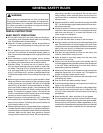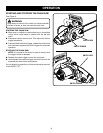
4
GENERAL SAFETY RULES
n Avoid body contact with grounded surfaces such as metal
pipes and wire fences. There is an increased risk of electric
shock if your body is grounded.
n Do not operate a chain saw that is damaged, improperly
adjusted, or not completely and securely assembled.
Chain should slow to a stop when the switch trigger is
released. If the chain continues to turn after the switch
trigger has been released, have the unit serviced by your
nearest Ryobi service dealer.
n Check for damaged parts. Check for alignment of mov-
ing parts, binding of moving parts, breakage of parts,
mounting, and any other conditions that may affect its
operation. A guard or other part that is damaged should
be properly repaired or replaced by an authorized ser-
vice dealer unless otherwise indicated elsewhere in this
manual.
n All chain saw service, other than the items listed in the
operation and maintenance sections, should be performed
by your nearest Ryobi service dealer.
n Always maintain a proper stance.
n Do not use chain saw if switch does not turn it on and off.
Have defective switches replaced by authorized service
center.
n Do not adapt your powerhead to a bow guide or use it
to power any attachments or devices not listed for the
saw.
n Disconnect chain saw when not in use, before servicing,
and when making adjustments and changing attachments,
such as saw chain and guard.
n Do not cut vines and/or small underbrush.
n Do not operate a chain saw in a tree, on a ladder, or scaf-
fold; this is extremely dangerous.
NOTE: The size of the work area depends on the job
being performed as well as the size tree or work piece
involved. For example, felling a tree requires a larger work
area than making bucking cuts.
n Use extreme caution when cutting small size brush and
saplings, because small material may catch the saw chain
and be whipped toward you or pull you off balance.
n When cutting a limb that is under tension, be alert for
spring back so that you will not be struck when the ten-
sion in the wood fibers is released.
n Do not force the chain saw. The job can be performed
better and safer at the rate for which it was intended.
n Always use the right product for your application. The
chain saw should be used for cutting wood only. Never
use the chain saw to cut plastic, masonry or non-wood
building materials.
n Do not use the chain saw for purposes not intended.
n Store chain saw when not in use. Chain saw should be
stored in a dry and high or locked area out of the reach
of children. When storing chain saw place the scabbard
on the bar and chain and store the chain saw in carrying
case.
n Save these instructions. Refer to them frequently and
use them to instruct others who may use this tool. If you
loan someone this tool, loan them these instructions
also.
WARNING:
Some dust created by power sanding, sawing, grinding, drilling, and other construction activities contains chemicals
known to cause cancer, birth defects or other reproductive harm. Some examples of these chemicals are:
• lead from lead-based paints,
• crystalline silica from bricks and cement and other masonry products, and
• arsenic and chromium from chemically-treated lumber.
Your risk from these exposures varies, depending on how often you do this type of work. To reduce your exposure to
these chemicals: work in a well ventilated area, and work with approved safety equipment, such as those dust masks
that are specially designed to filter out microscopic particles.


















